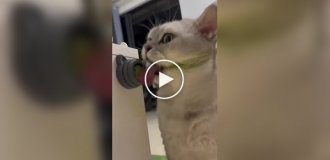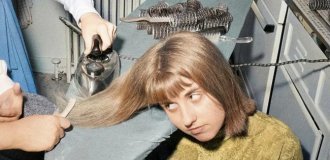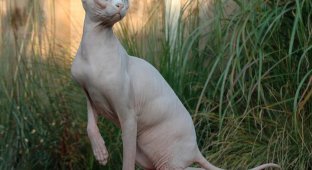Our affectionate, wayward and such beloved friends...
21. Munchkin
Very unusual cats. With an average body length, their legs are 2-3 times shorter than those of ordinary cats; because of this feature, they are sometimes called dachshunds. But the oddities are not limited to appearance. While ordinary cats stand on their hind legs to look around, the munchkin sits on his hips and firmly rests his tail. Cats can remain in this position for quite a long time, and the short legs hanging on the sides give them a resemblance to a kangaroo, which looks quite comical. This breed did not arise as a result of selection, but due to a spontaneous mutation around the 30s. last century, in any case, it was at this time that Europe was excited by reports of funny short-legged cats; in 1953, short-legged cats were seen in Stalingrad. They arrived in Russia in 2001. Many munchkin owners note that their pets do not like to meow a lot and loudly. Very active, smart, playful. Breeders note that cats of this breed love to follow their owner on a harness. They are also said to be very docile and can learn to follow some vocal commands.

20. Turkish Angora (Angora cat)
One of the most ancient breeds of long-haired cats, whose homeland is Türkiye. It is often confused with Persian. Although they are neighbors ("Angora" is a modified name for Ankara, and the capital of Turkey is not that far from Iran, formerly Persia), there are significant differences between them. The Turkish Angora is much smaller than the Persian, more agile, lighter, slimmer, and its nose does not have a notch at the base (foot), like the “Persian”. Angora cats came to Europe at the end of the 16th century through France, so they were called French for some time. Currently, purebred Angora cats are quite rare. In Europe, the Turkish Angora, unfortunately, randomly crossed with cats of other long-haired breeds, primarily with Persians. Therefore, for successful breeding work, Angora cats are used, if possible, from Turkey, where they still live at home, and in the cages of the capital's zoo. Lively, smart, sociable. They have a calm, even disposition. Turkish Angoras are intelligent and loyal, adapting well to different living conditions.

19. Persian cat
This is a breed of long-haired cats. There is much that is unclear about the origin of this breed. Apparently, desert and Asian steppe cats, which lived in ancient times in the territory of Near Asia, took part in its formation. Türkiye is considered the birthplace of the Persian cat. The history of breeding the Persian cat in Europe begins in the 16th and 17th centuries, when it was introduced to Italy and then to France. The animal has become widespread and popular. The Persian cat, compared to other breeds, shows the highest degree of domestication. She has even lost the ability to catch mice and rats and cannot live outside the house. The Persian cat has an affectionate character and complete trust in humans, and is very calm. Her devotion to a person can be compared to the loyalty of a dog.

18. American Curl
The origin of the American Curl is associated with the domestication of a stray cat. The ancestor of the breed is considered to be a cat named Shulamith, distinguished by black silky hair and unusually shaped ears. In 1981, Shulamith gave birth to four kittens, two of which had the same inverted ears. In 1983, the American Curl breed was shown in California and was recognized in the United States. These cats first came to Europe only in 1995 and are not yet recognized by FIFe and the British Coordinating Council for Rare Cat Breeds. The American Curl's personality is a mixture of loyalty, tenderness, cheerfulness and curiosity. Good health and ease of care complete the picture of the ideal cat. American Curls retain their playfulness and curiosity throughout their lives.

17. Mekong Bobtail (Thai Bobtail)
The first Siamese, or rather the ancestors of all subsequent breeds, from which the Mekong Bobtails branched off, were brought to Europe in 1884 from the “City of Angels”, Krung Thep, the capital of Siam. They were brought to America in 1890; in Russia, the mention of the first representatives of the Siamese is associated with the royal palace at the beginning of the 20th century. Later, the development of the breed followed the path of culling cats with “royal” broken tails. In Russia, thanks to the efforts of enthusiasts, despite the stubborn official non-recognition by felinology, the Mekong bobtails were preserved, and were even replenished with representatives exported from the countries of Southeast Asia. For fifteen years, the Moscow club "Korgorushi" has been breeding Mekong Bobtails with the participation of individuals from China and Laos, Burma and Vietnam, Iran and Mongolia. Therefore, the main characteristics of the breed are maintained perfectly. And such quality as the tail in one quarter of the body and the creases, the shape of the tail and the texture of the coat are beautiful. A feature of the Mekong Bobtail breed is its longevity. Cats taken from their homeland and their descendants live 20-25 years. And they remain active and fertile until the end. Cases have been recorded where a cat couple aged 22-23 years gave birth to healthy, strong offspring.

16. Singapore cat
The Singapore cat breed was formed in the countries of Southeast Asia. Her homeland is Singapore. In 1976 it came to the USA, where in 1981 a standard was developed and it was recognized. The cat is small in size (2-3 kg), differs from other breeds in a number of exterior characteristics. The Singapura cat's coat is short, very fine, soft, silky, and lies tightly to the body. In a cat it is usually longer. "Singapore" is an elegant, very cheerful and active cat, obedient, funny, and a favorite of children.

15. Selkirk Rex
The Selkirk Rex is a cat breed that includes two varieties - shorthair and longhair. Released in 1987 in the USA. The very first Selkirk Rex was short-haired; it was crossed with a Persian cat by an American felinologist from Montana, Jerry Newman. As a result, short-haired and long-haired kittens with a combination of curly and straight hair were born. Therefore, from the very beginning, the Selkirk Rex breed included two varieties, differing in the type of coat. The breed is recognized by TICA and other associations are also interested in it. The character is flexible, the coat requires very careful care.

14. Russian blue cat
The Russian Blue is a breed of domestic cat, recognized by international felinological organizations, which became known in Russia only with the beginning of the felinological movement. The Russian blue cat is successfully bred abroad. She is one of the most popular breeds of short-haired cats. The sale of kittens is most common in Sweden, Finland, Norway, the Czech Republic, Slovakia, and Hungary. This is one of the most famous breeds in the world. The origin of this breed is surrounded by legends. Probably, the Russian Blue is the oldest aboriginal cat breed in Russia, originating from the cats of the ancient Slavs, and possibly from the proto-Slavic tribes - the Ants, which is reflected in Russian folklore in the image of the mythical Cat-Bayun, who accompanied the Slavic pagan god Veles. The Russian blue cat was first mentioned in the chronicles of the times of Peter I. In them there is a mention of his cat, Vaska, who was everyone’s favorite. Later, Catherine II presented Russian blue kittens as gifts to ambassadors of foreign powers.

13. Bengal cat
The Bengal cat was developed by crossing the Asian leopard cat with domestic cat breeds such as the Abyssinian, American Shorthair, Burmese and Egyptian Meow. Bengal cats are loving, loyal and very responsive to their loved ones. They build strong relationships with their owners and become loyal friends for life. They communicate with people and have a deep need to open up to them about their feelings. Despite its rise in popularity, the Bengal breed is certainly not a cat for everyone. Owners of Bengal cats note that the character of this breed is completely devoid of aggression, even to the slightest degree. Bengal cats are very smart, which is not surprising, since their ancestors needed to have enough intelligence, as well as sharp claws and fangs, to survive in the wild. Bengal cats are quick learners and can learn many tricks, including how to play various games. True, owners of Bengal cats are not always happy with some of their pets’ skills, especially such as turning lights on and off, opening doors and flushing the toilet.

12. Abyssinian cat
Its ancestor is considered to be a wild African cat that lived in Abyssinia (now Ethiopia). The first Abyssinian cat was named Zula. It was brought by a member of the British military expedition, Captain Barrett-Lenard, in 1868. Abyssinian cats are extremely attached to their owner and cannot be alone for long. Active and mobile. They are in great need of affection and attention, but at the same time do not require special coat care. Quite quiet, preferring tactile communication to verbal. Often a female's heat goes unnoticed by the owner. The average litter of an Abyssinian cat is from 1 to 3 kittens, but there are times when an Abyssinian cat gives birth to up to 6 kittens.

11. Cymric
The Cymric breed was created in the USA in 1960 after a long selection work on the basis of the shorthaired Manx cat. The more poetic name comes from the ancient Celtic name for Wales, which, according to some sources, has its own species of tailless cats. Unlike Manx, Cymry cats can be mated with each other, but there is one peculiarity - a tailless Cymry cat needs a cat with a short tail. They are the same calm and obedient animals as their Manx relatives. Moves by jumping like a rabbit.

10. American Shorthair cat
Emigrants who left Europe in the 1600s in search of a new life in America packed their belongings and set sail. There were also cats with them. These animals did not claim titles of nobility, they were simple domestic creatures. However, a group of fanatical breeders, having skillfully added the blood of a number of local cats, fixed a new breed: original, strong and beautiful, these cats delighted people and subsequently received recognition at exhibitions. So an ordinary European cat, brought by immigrants, solemnly received American citizenship. She was given the name Buster Brown. The American Shorthair cat is distinguished by its endurance, love of jumping, excellent health, and shows its courageous character in various situations. Sometimes he shows himself to be a good hunter. It should also be noted that this is an affectionate, gentle and smart cat.

9. Toyger
Toygers are still in the process of development. The Toyger breed was recognized only in the early 90s. The long-term goal of breeders is to make the breed even more similar to tigers. Some of the characteristics of this breed have never before been recognized among existing domestic cats. Progress is slow but steady in all areas. The Toyger was introduced in May 2006 as a new breed by TICA. This breed of cat, bred in America, resembles a tiger in color. Registered by the International Cat Association in 2007. For the first time, the idea to breed a “tiger cat” came from Jane Mill in the 80s. This happened as a result of work on Bengal cats; it was then that the first kitten with stripes on its face and body was born. This is a designer cat breed. It is designed and bred to meet the demands of modern life, to be a companion and friend to man. Kind cats with a soft character and the appearance of tigers will not leave anyone indifferent. Toygers have a very playful character: they are active and sociable. They are very loyal to their owners.

8. Maine Coon
Maine Coon cats are distinguished by their luxurious coat, impressive size and friendly disposition. These representatives of the largest breed of domestic raccoon cats have been known for several centuries and are extremely popular. The optimal weight of cats presented at exhibitions is 8-10 kg, cats are slightly smaller - from 5 kg. One of the significant differences between cats of this breed and others is their character: they are kind and tactful. Although the Maine Coon looks more like an aristocratic and evil predator, in fact it turns out to be a good-natured and gentle creature. Representatives of this breed will not harm either their owners or their children; they become true friends and willingly play with children. The Maine Coon will become a faithful assistant in business; she loves to be close to her owner, but at the same time she is absolutely not annoying. If you are busy and cannot pay attention to your pet, she will not impose herself. Such cats are very intelligent, so owners will not face such a problem as vigilantly monitoring their pet. These cats are very loyal to their owners; they behave calmly with strangers, without familiarity or discontent. But at the same time, the Maine Coon is ready to defend its territory from the invasion of other animals.

This is a breed of shorthair cat that was created by crossing a spotted American Shorthair cat with a Siamese cat. By the 1980s, the breed already had its own standard. A distinctive feature of these animals were four white paws, a white stripe on the muzzle and the same white spot on the chest. Snowshoes love people. They are very gentle, charming, affectionate, affectionate, and are never in a nervous or excited state. The presence of Snowshu in the house ensures peace and goodwill of all family members. As a rule, Snowshu accompany their owners everywhere, constantly being nearby. They love to play with the owner, finding hidden small things in the house. Snowshu are kind and insightful, tolerant of children. Their advantages include the lack of vocal abilities, which their Siamese ancestors are so proud of.

6. Scottish fold cat (Scottish fold)
The first cats of this breed were bred in Scotland in 1961. In the East, fold-eared cats were known centuries ago. She has a balanced character, great affection for home and people, and is unpretentious. You can feel the breed in them, and even intelligence, their behavior is reasonable, stupid aggression is not characteristic of these animals.

5. Exotic shorthair cat
The Exotic Shorthair was developed in America by crossing American Shorthair cats with Persian cats and was originally called the Persian Shorthair. Officially recognized in 1966. The animal is calm, affectionate, agile and playful. You can buy an exotic shorthair cat in a specialized cattery.

4. Burmilla
Launched in 1981 in the UK. From an accidental crossing of a Burmese with a Persian chinchilla, charming kittens of a shaded silver color were born. After this, specialists began breeding work, intensively cultivating Burmese characteristics with each generation. A little later, varieties of Burmilla appeared, differing in color. The Burmilla breed was recognized by the GCCF in 1989 and by the FIFe in 1994. Burmilla has a balanced character, is not aggressive in the company of other cats, and loves to play with various objects. The coat needs to be brushed regularly.

3. Ragdoll
A breed of semi-longhaired cats. Brought to the USA in the late 1960s. As the name suggests (“rag doll”), this cat is soft, affectionate, and very pliable. Fans of this breed claim that ragdolls replace children in the family. They are smart, affectionate, playful, and get along well with other animals. True, they do not know how to defend themselves, and therefore they hide. With their character, Ragdoll kittens often resemble dogs - like dogs, they follow on the heels of their owners.

2. British Shorthair (British)
These are strong, smart, robust, active short-haired cats. They come in medium to large sizes. British cats are distinguished from other breeds by their special independence. They are often called the "businessman's cat" because the British tolerate loneliness quite calmly and find something to do during this time. Very dexterous and fast cats, excellent mouse catchers (if required). They meow, as a rule, rarely, quietly and quite peculiarly (a little like grunting or some kind of croaking sound).

1. Siberian cat
The Siberian cat was bred in Russia. Apparently, it comes from crossing local native cats with those imported from other countries, including Near and East Asia. The breed was recognized by the World Federation of Cat Fanciers (FIFe) in 1992. Since 1987, we began work on their breeding in Russia. Thanks to the enthusiasm of a handful of hobbyists, this breed has become popular throughout the world today. Since 1986, this animal has also been bred in Europe. The character of “Siberians” is very independent, they are excellent hunters. And at home, this is an imposing, affectionate creature that can relieve any stress from its owner. The cat is quite active, affectionate, playful, unpretentious and hardy. Easily toilet trained. However, sometimes it shows willfulness, is restless and does not always respond with affection to the owner’s attention, that is, it is subject to the influence of mood. Well adapted to living conditions in temperate and middle latitudes. Not afraid of water. Gets along well with dogs of any breed.























